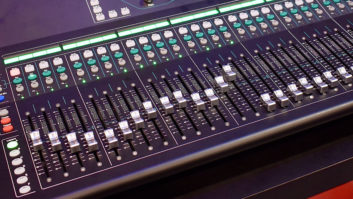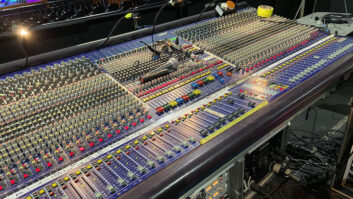
Earlier this week, Sennheiser made public the news that it’s been developing a new type of wireless technology that looks like it could be a game-changer for large-scale, multi-channel RF applications such as major sporting events, theaters and broadcast studios.
The technology is called Wireless Multi-Channel Audio Systems, or WMAS. If it delivers as promised, it could be the biggest development in wireless instrument technology in decades. WMAS is a bi-directional, broadband wireless technology capable of combining microphones, instruments, in-ear monitors and remote control—into one broadband RF channel.
The vast majority of professional wireless systems used in entertainment are narrow-band systems requiring a bandwidth of 200 kHz each, typically transmitting at a power of 50 mW. As the number of narrow-band wireless systems deployed in a locale increases, so does the amount of “power on air,” or energy in the RF band (aka RF clutter). If you’re running, say, 30 channels of wireless instruments, mics and IEMs—that’s 1.5 watts on air, and plenty of activity to produce intermodulation or interference with nearby devices. The transmit power of a WMAS is also 50 mW—but the entire system operates at 50 mW regardless of the number of audio channels being transmitted.
WMAS transmits across a broad band: 6 MHz in North America, 8 MHz in European countries. Unlike narrow-band wireless, that 50 mW transmission is not concentrated within a 200 kHz band. Instead, it’s spread across the band, the result being a power spectral density* that’s 30 times lower than that of a conventional wireless microphone, or 40 times lower when used with an 8 MHz bandwidth.
[*Power spectral density is a measure of total signal power in a specified spectral bandwidth divided by that bandwidth, expressed in watts per Hertz].
One of the benefits of reducing power spectral density is that an RF channel can be “reused” more easily. In this case, the term “reuse” means the ability to operate a wireless unit on the same channel as your neighbor. Conventional wireless wisdom dictates that you need to be roughly a quarter-mile away from your neighbor to prevent interference when operating on the same RF channel. Two neighbors using WMAS, however, could be less than half that distance apart and still operate without interference. Translation: high-density RF environments such as Broadway would have a lot less trouble securing channels on which to operate because neighbors would be able to reuse a channel.
You may have noticed I used the word “bidirectional” in the first paragraph. A WMAS belt pack can serve as an instrument transmitter and IEM receiver simultaneously, reducing the number of packs worn by a performer. Furthermore, the allocation of channels will be greatly simplified because an instrument transmitter and IEM receiver are able to operate on the same RF channel.
Contrast that with the current convention of operating wireless mics and instruments in one vacant channel, while IEMs are relegated to a separate vacant channel in order to reduce blocking of the IEM receiver. WMAS allows multiple mobile devices (i.e., the handheld mics and body packs) to be linked to a single rack unit, so no more 20-space road racks filled with RF gear.
Also By Steve La Cerra:
Audix A127 Microphone — A Mix Real-World Review
Mix Blog: Bluetooth High-Quality Streaming on the Horizon
WMAS provides a user-friendly, flexible workflow. According to Sennheiser, “The WMAS base station identifies a vacant channel. The WMAS mobiles (i.e., transmitters and/or transceivers) then sense the beacon signal from the base station and automatically link to it. The audio engineer determines the required number of audio channels and then can fine-tune the parameters of each individual audio channel in terms of audio quality, operating range, and latency. The WMAS will allocate the necessary spectral resources to each channel to fulfill those requirements.”
One example would be prioritizing spectral resources for the star of a show to ensure their IEMs had the lowest latency, highest fidelity and greatest transmission range, while stationary members of the band (keyboard players, drummers) could have spectral resources with reduced range since those performers are not as mobile.
But wait… There’s more!
Because there’s bidirectional communication between a WMAS base station and the mobile units, it is possible to have dynamic resource allocation. I called it first: “DRA.” DRA allows an engineer to allocate spectral resources in a WMAS where they’re most needed. An example would be at large festivals where the majority of spectral resources could be allocated to the band that’s performing on stage, while the band that’s up next receives only enough spectral resources to confirm that the packs are powered on, linked and ready to transmit (sort of an RF standby). When the first band is finished, the engineer calls up a new allocation, instantly switching the resources to the gear used by the second band.
As mentioned earlier, a WMAS channel requires significant bandwidth: exactly the bandwidth required by a television channel. This is not an insignificant chunk of RF landscape, but—given the fact that most major cities have at least one unused TV channel, and that the low transmission power of WMAS results in decreased potential for WMAS to interfere with other forms of transmission (specifically TV and other wireless microphone operators)—it makes absolute sense for regulatory agencies to clear the use of WMAS. The technology has already been cleared for use in many overseas countries. Now we need to get the FCC onboard. Stay tuned…
The author wishes to thank Joe Ciaudelli, Director of Spectrum & Innovation for Sennheiser, for help with this article.







